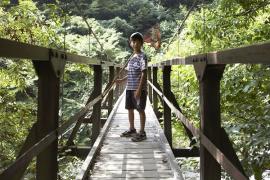During the spring of each year, many camp directors are faced with what can seem to be an overwhelming task of planning for staff training. While it is tempting to use the same "recipes" from previous years, this can be hard to swallow for returning staff. Because of the large amount of information that needs to be conveyed in a short amount of time, it makes sense to present training topics in a way that will maximize the learning and retention capacity of staff (and have fun while doing it!).
Dr. Marcia Tate presented twenty brain-based teaching techniques at the ACA National Conference in Chicago (2006) during her keynote address, and the implications of this work can have a huge impact on the way in which staff training is designed and implemented. Ingredients for the above menu items are based on several basic principles of understanding how the brain learns best and how this information can be applied to staff-training sessions. The school where I currently teach, St. Andrew's Episcopal Day School, in Ridgeland, Mississippi, had the fortune of working with learning consultant, Kimberly Carraway, of the Carraway Center for Teaching and Learning in Nashville, Tennessee, for several years developing strategies to teach students the "how to" of learning. The following basic principles are just a few of the many ideas Carraway shared and how they relate to planning and executing staff training for each new camp season.
One of the most fundamental ideas regarding how the brain works is that emotions greatly influence learning. The arrival of staff at camp can trigger an onslaught of emotions, and if staff are anxious about their new environment or do not feel comfortable in their summer home, this can affect the way in which information is received and retained during training. A second key principle is that the brain remembers words better than pictures. In addition, when information is solely presented in a lecture format, on average, only 5 percent of the information is recalled twenty-four hours later. However, 90 percent of the information will be remembered if it is taught to someone else. Those statistics alone should be reason enough to redesign the way in which information is presented during staff training!
Another key principle of how the brain learns best is that when planning the length of training sessions, it is important to remember that the percentage of information remembered increases as the learning episode shortens and decreases as the lesson time lengthens. Having sessions that are several hours in length without any breaks can hamper the brain's capacity for assimilating the amount of information. The brain also remembers best what is taught first and last. It is crucial to think about the placement of training topics within the entire time frame of staff orientation (what is presented on the first day and the last day); the order of any given day (topics that are first on the schedule or at the end of the day); and the sequence of each training session (the opening and closing activity). This article suggests many creative ways to avoid the "muddy middle" and capitalize on the number of beginnings and endings in any given session.
Finally, in learning, at least 40 percent of the time should be spent reviewing new information. It is essential to build in opportunities to re-cap training topics often throughout a session — it can be done in just sixty seconds! Knowing the key principles of how the brain learns best will make a noticeable difference in the effectiveness of future staff-training sessions.
You are cordially invited to sample from the following five-course smorgasbord of easy-to-use, brain-based training techniques that are guaranteed to satisfy a hearty appetite.
Appetizers
Take advantage of knowing that what is taught first and last is remembered most by priming staff for upcoming learning through creative ways that "hook" the learner. Choose from the following "appetizers" that will set the tone for the rest of the training session:
- Preview the training topic or session — Create a "menu" similar to one in this article or send an "invitation" to staff prior to a training session.
- Give out or have staff bring a random object to the meeting to pique curiosity about the training topic — Have staff bring a "hat" to be used when it is time to re-cap ideas or give a fork to use when it is time for "dessert."
- Pose a question — Give staff time to brainstorm possible answers before asking for a group response.
- Give a short "quiz" on a topic — Determine what staff already know using a brief quiz.
- Present a challenge or problem to solve as a way to introduce a topic — Use the game of "SKUNK" , which is a fun dice game that can be used to show staff the difference between leaving decisions in a typical camp day up to "chance" and making intentional "choices."
At fancy restaurants, a palette cleanser is often given between courses. Letting staff make connections to their own learning goals, previous knowledge about a topic, and to other staff is one way to prepare the taste buds for learning; for example, share two to three questions with a partner about the training topic. Another idea is to have staff look at the end product at the start of orientation. Ask your staff to consider the question: How do you want to be remembered by your campers at the end of the summer/session? Staff will brainstorm ideas and get a mental picture of some of the characteristics a great counselor has and how orientation training will provide the tools needed to develop this more when working with children at camp.
Course 1: Brain Bites
The next list of brain-based strategies feeds the brain in ways that optimize learning and maximize retention when presenting the "meat" of a session:
- Provide opportunities to brainstorm and discuss — Sharing with a partner maximizes the time each person is engaged in a brain-storming session since there is an opportunity to contribute up to 50 percent.
- Incorporate humor — Jokes, comics, and cartoons are good ways to grab the attention of your staff.
- Use interesting props — Wear an apron when "cooking" up ideas, use toilet paper to design the typical camper at various ages/stages.
- Incorporate metaphors/analogies — The restaurant theme of this article works well.
- Use mnemonic devices — MAGIC = Make A Great Impact on our Campers was a staff theme at Camp Broadstone in North Carolina last summer.
- Play games to introduce/review — Games such as Jeopardy, Bingo, and Deal or No Deal are fun to use.
- Use the concept of a jigsaw puzzle for learning — Divide into groups. Assign each person to become an "expert" on one aspect of a topic and teach others in group.
- Integrate storytelling into your training — Use The True Story of the Three Little Pigs by Jon Scieszka to introduce "twists" to camp programs and activities.
- Have staff take notes — I call this the grocery list phenomena. If it is written down, ideas will be remembered better; even notes are not referred to again.
- Create a slide show — Use a digital camera to take pictures of what it looks like to work with campers of a particular age/stage and display it on big screen while members of a group explain the presentation to the entire group.
Similar to taking a break between courses of a meal, it is important to make time for letting ideas "digest" before transitioning to a new topic. Incorporating occasions to re-cap regularly throughout training tremendously increases the likelihood that staff will remember the key points of a given training; however, it is often the part of the "meal" that gets overlooked because of time restraints. The following activities can be completed in about sixty seconds; spending just a little time will go a LONG way!
- Wear a Hat — Have staff wear a hat to signify this part of the training; this activity incorporates a prop and draws attention to what is being accomplished at this stage.
- Banana Split — Have a short discussion with a partner to review key concepts.
- Check, Please! — In this activity, the leader shouts a number and staff respond out loud with facts they know, questions they have, ways they can use information presented, etc.
- Waiter! — Use physical signals to show level of agreement — clap hands, snap fingers, stomp feet.
- Tip Jar — Have staff write a "wow!" in which each staff person writes three main ideas/questions on an index card or graffiti wall right before a break.
- Bit-by-Bit — Review a topic by saying one word and directing a person in the group to summarize.
Course 2: Movement Morsels Accompanied by Music
This is one restaurant where it is OK to get up from the table every now and then . . . in fact, the chef insists that all learners move around for instructional purposes! Serve up extrasensory input to the brain, and memory for learning will be enhanced in your staff. Use the following activities to encourage movement and learning:
- Form Creative Groups — Use different ways to vary staff groupings: animal sounds, birthday month, etc. • Middle of the Road — Put tape down on the middle of the floor and have staff show where they stand on various issues.
- Four Corners — Give a multiplechoice "test" and instruct staff to show their answers by moving to the corner of the room marked with A, B, C, or D.
- Food Court — Just like in a shopping mall, staff go to different stations to learn various aspects of topic.
- Ball Toss — Permanent markers can be used to write on the surface of beach balls for brainstorming ideas and answering questions related to a topic.
- Walk/Talk About — Have staff walk the perimeter of a room or take a "lap" around the outside of the building where training is held and discuss main ideas of topic.
- Role play, Skits, Charades — All are interactive ways to engage staff!
- Try a Different "Restaurant" — Switch training locations often during orientation: visit the campsite when discussing overnights, go to the dining hall when reviewing mealtime procedures, etc.
- Pick a New Seat — Changing the orientation of a room can give staff a new perspective or make a clear transition from one topic to another; for example, have staff face the back of a room, sides, or other positions. Encourage staff to sit in chairs, on the floor, etc.
- Change Words to a Camp/Popular Song — There are endless options with this one!
- Play Music — Staff respond well to upbeat music when they enter a room, during a break, or to transition from one activity to the next; it can also be used during brainstorm sessions or when a ball is being passed around from person to person. Stopping the music can determine the next staff member to answer a question or share an idea.
In case this article is making you hungry, chances are your staff is thinking about eating, too! There are many choices that can be used as "fidget foods" to complement learning or reinforce training ideas. Here is a list of discussion themes to snack on:
- Gummy Worms — Get hooked!
- Skittles/M&M's — Share one idea for each color.
- Licorice — Activity "twists."
- Gum — Name three things that will "stick" with you.
- Pay Day — Something learned that will "pay off."
- Hershey's Treasure — Share a treasured memory from a session.
- Red Hots/Hot Tamales — Name three things that got you "fired up"!
- Fortune Cookies — Place slips of paper inside with discussion questions, jokes, etc.
- Healthy Choice — What are you feeling "green" about?
- Carrots — What is motivating to you? (Contributed by Genie Gunn of Victory Junction Gang Camp, North Carolina)
Course 3: See-Food Sampler
This next course of activities is designed to feed the eyes in powerful ways that will help move information from short-term to long-term memory:
- Today's Specials — Post a sign outside the training room or on a bathroom mirror to give a preview of upcoming training topics.
- Graphic Organizers — Fold a piece of paper into a "napkin," and use it to draw diagrams, show relationships, identify sequence of events, cause/ effect, etc.
- Write Key Words/Phrases on a Flip Chart — Use colored markers in this activity for emphasis and distinction.
- Visualization — Have staff think back to when they were eight, eleven, or fourteen years old.
- Handouts — Incorporate fill-in-theblanks, lots of white space, and clip-art in your handouts.
- Code Notes — Give staff the opportunity to interact with written information so that they will remember it: star/underline/circle key points, use a question mark to indicate further clarification or post-it-notes, etc.
- Doodles — Find a spot at camp to create images that represent concepts learned using sidewalk chalk.
- Text Messages — A staff member was late arriving to orientation, create a text message of the main ideas of a training session that could be sent to him/her.
Dessert — Save Your Fork!
Whenever eating a meal at my grandmother's house, it was known that "save your fork" indicated that dessert was about to be served. The menu items in this section are designed to be the "sprinkles on top" of any training session. Save the best for last, and staff will be talking about orientation all summer long!
- Doggie Bag — Put key points from orientation on slips of paper, and refer to them at a future staff meeting.
- Later Letters/Postcard — Ask staff to write down the highlights of orientation in the form of a letter and then give them the letter later in the summer as a reminder.
- Shaving Cream — Ask staff to write the most important points of the training session in shaving cream on your dining hall tables and clean then clean the tables off. Learn and clean at the same time!
- Play-Doh/Wire/Pipe Cleaner/Paper Creations — Use an interesting medium for staff to create a summary of orientation training.
- Impression Feet/Hands — Order fun pieces from Michelle Cumming's Web site, www.training-wheels.com, and have staff share impressions from recent training.
- Food for Thought — Lead another great activity by Michelle Cummings that uses the table setting as a metaphor for training topics: knife = information that should be "spread" around; fork = something staff would like to take a "stab" at this summer; spoon = what staff need help with; plate = what is on your plate?; etc.
- Decorate a Cake! — When I have presented this session to camp leadership staff, they have a great time using frosting and other edible items to decorate a cake that signifies the main ideas of brain-based training. After discussing the different creations, the best part is eating the ideas that were learned as the grand finale of a fivecourse meal!
One of the dangers of dining at a restaurant serving smorgasbord-style is that there can be too many items to choose from, and it is hard to sample everything that is prepared. The menu of ideas shared in this article does not have to be consumed at one sitting or used in one orientation training. Below are a few tips from the chef so that you can put on your apron and get ready to cook up a delicious staff orientation this summer!
After Dinner EncourageMINTS From the Chef
- Aim for a candlelight dinner at a fancy restaurant versus going through the drive-thru when planning the menu of training topics for orientation training.
- Take a "no thank-you" helping. You never know if you will like it unless you try it!
- Cut down on portion-size of training sessions and meet more often.
- Don't bite off more than your staff can chew at any one time. (Less is more!)
- Training Food Pyramid: Feed the eyes more than the ears.
- Give staff time to digest their food after each "course" . . . it only takes sixty seconds!
- Training sessions should be interactive and engaging. (Remember how painful it is to see two people eating dinner and no one is talking?!)
- It is OK to get up from the table every now and then or try a new restaurant location.
- Re-fills are always free!! Staff need opportunities to quench their thirst for more information on training topics throughout the summer.
- Avoid over-eating . . . too much training makes for sleepy staff. You can always go back later for seconds (and thirds). Have a snack later!
- Save a fork and room for dessert. It will be remembered long after the training session is complete.
- Put any leftover ideas in the freezer, and take them out later in the summer during on-going staff meetings/ trainings. You can even take out unused ideas next year!
| References |
| Bowman, S. (2005). The Ten-Minute Trainer: 150 Ways to Teach It Quick and Make It Stick! John Wiley & Sons. |
| Carraway, K. (2004). Applying Brain Research: How Neuroscience Informs and Influences Your Teaching. Carraway Center for Teaching and Learning, LLC (Nashville, TN). (www. carrawaycenter.com). |
| Evanski, J. (2004). Classroom Activators: 64 Novel Ways to Energize Learners. Corwin Press, Inc. |
| Tate, M. (2003). Worksheets Don't Grow Dendrites: 20 Instructional Strategies That Engage the Brain. Corwin Press, Inc. |
Kim Aycock, M.S.T., is equally comfortable and effective teaching in a school classroom, working with camp staff during orientation training, or presenting educational sessions to camp leaders. She can be reached at 601-832-6223 or [email protected].
Originally published in the 2009 January/February issue of Camping Magazine.




